Analyzing the Importance of HASS Curriculum in Primary Schools
VerifiedAdded on 2023/01/16
|8
|2585
|78
Essay
AI Summary
This essay critically examines the significance of the Humanities and Social Sciences (HASS) curriculum within the Australian primary school setting. It begins by establishing the crucial role of HASS in fostering informed, engaged citizens capable of addressing societal challenges. The essay then delves into a literature review, emphasizing the impact of HASS on developing crucial skills such as critical thinking, social understanding, and civic efficacy. It highlights the importance of inquiry-based learning, values-focused education, and the integration of ICTs as key components of effective HASS teaching. The discussion further explores the Australian curriculum's framework, its emphasis on student curiosity, and the teacher's role in connecting students to the broader social context. The essay also analyzes curriculum planning, emphasizing the benefits of spiral curriculum approaches and the need for comprehensive teaching strategies to ensure student success. The conclusion reinforces the value of HASS in equipping young learners with the knowledge, skills, and attitudes necessary for navigating an increasingly complex world, aligning with the Australian Curriculum's goals of fostering active and informed citizens. The essay also highlights the importance of the subject for students at a tender age.
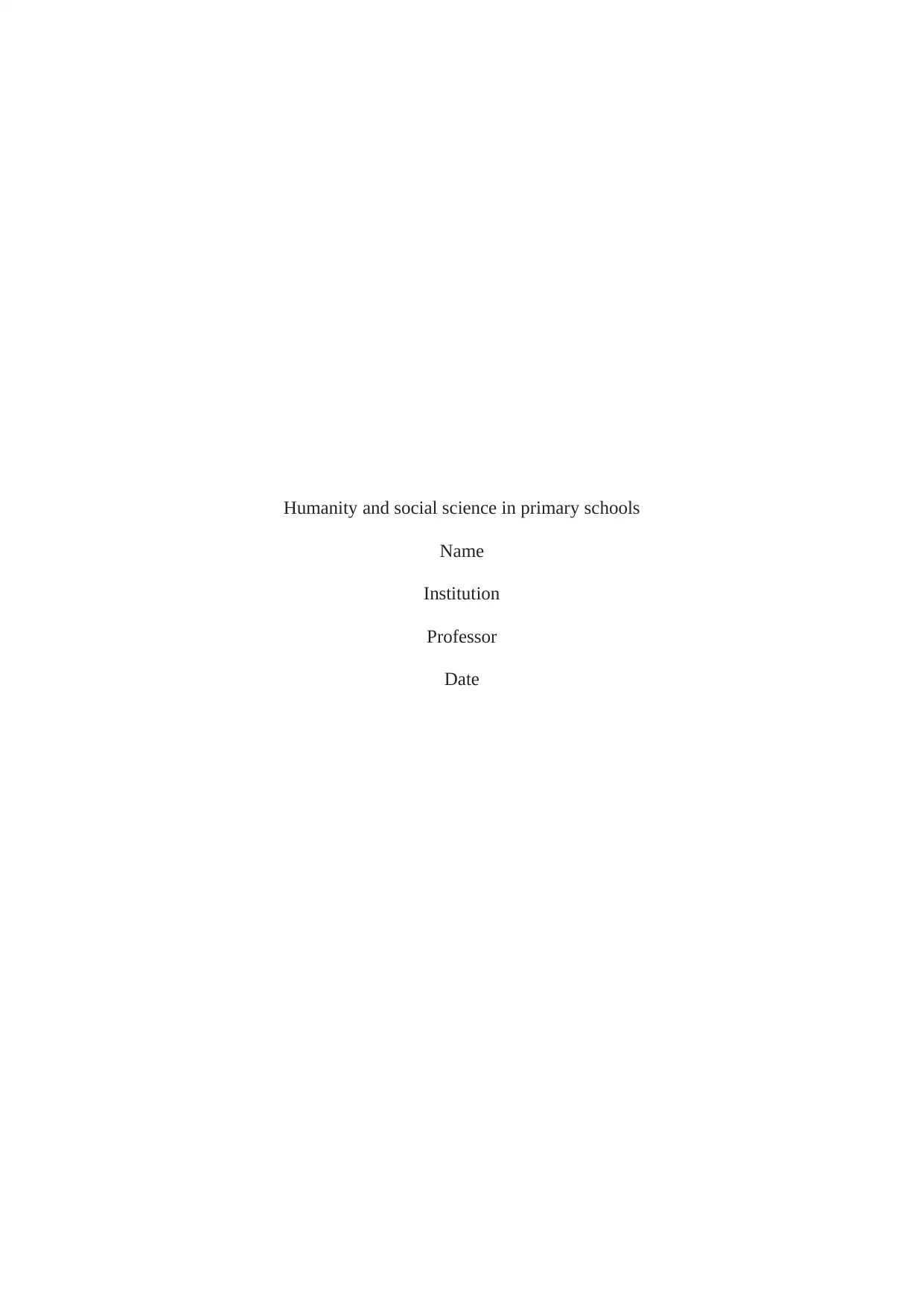
Humanity and social science in primary schools
Name
Institution
Professor
Date
Name
Institution
Professor
Date
Paraphrase This Document
Need a fresh take? Get an instant paraphrase of this document with our AI Paraphraser
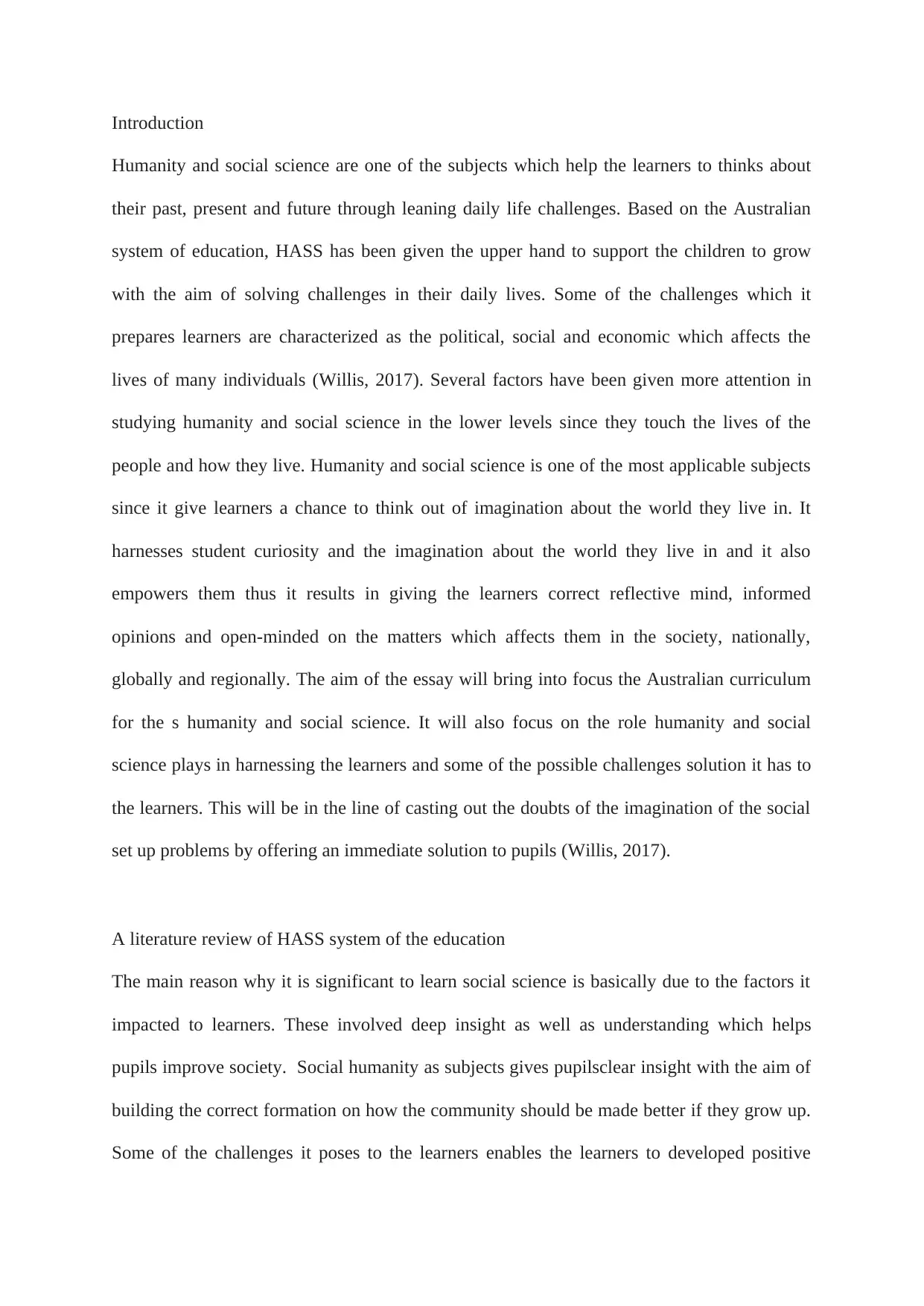
Introduction
Humanity and social science are one of the subjects which help the learners to thinks about
their past, present and future through leaning daily life challenges. Based on the Australian
system of education, HASS has been given the upper hand to support the children to grow
with the aim of solving challenges in their daily lives. Some of the challenges which it
prepares learners are characterized as the political, social and economic which affects the
lives of many individuals (Willis, 2017). Several factors have been given more attention in
studying humanity and social science in the lower levels since they touch the lives of the
people and how they live. Humanity and social science is one of the most applicable subjects
since it give learners a chance to think out of imagination about the world they live in. It
harnesses student curiosity and the imagination about the world they live in and it also
empowers them thus it results in giving the learners correct reflective mind, informed
opinions and open-minded on the matters which affects them in the society, nationally,
globally and regionally. The aim of the essay will bring into focus the Australian curriculum
for the s humanity and social science. It will also focus on the role humanity and social
science plays in harnessing the learners and some of the possible challenges solution it has to
the learners. This will be in the line of casting out the doubts of the imagination of the social
set up problems by offering an immediate solution to pupils (Willis, 2017).
A literature review of HASS system of the education
The main reason why it is significant to learn social science is basically due to the factors it
impacted to learners. These involved deep insight as well as understanding which helps
pupils improve society. Social humanity as subjects gives pupilsclear insight with the aim of
building the correct formation on how the community should be made better if they grow up.
Some of the challenges it poses to the learners enables the learners to developed positive
Humanity and social science are one of the subjects which help the learners to thinks about
their past, present and future through leaning daily life challenges. Based on the Australian
system of education, HASS has been given the upper hand to support the children to grow
with the aim of solving challenges in their daily lives. Some of the challenges which it
prepares learners are characterized as the political, social and economic which affects the
lives of many individuals (Willis, 2017). Several factors have been given more attention in
studying humanity and social science in the lower levels since they touch the lives of the
people and how they live. Humanity and social science is one of the most applicable subjects
since it give learners a chance to think out of imagination about the world they live in. It
harnesses student curiosity and the imagination about the world they live in and it also
empowers them thus it results in giving the learners correct reflective mind, informed
opinions and open-minded on the matters which affects them in the society, nationally,
globally and regionally. The aim of the essay will bring into focus the Australian curriculum
for the s humanity and social science. It will also focus on the role humanity and social
science plays in harnessing the learners and some of the possible challenges solution it has to
the learners. This will be in the line of casting out the doubts of the imagination of the social
set up problems by offering an immediate solution to pupils (Willis, 2017).
A literature review of HASS system of the education
The main reason why it is significant to learn social science is basically due to the factors it
impacted to learners. These involved deep insight as well as understanding which helps
pupils improve society. Social humanity as subjects gives pupilsclear insight with the aim of
building the correct formation on how the community should be made better if they grow up.
Some of the challenges it poses to the learners enables the learners to developed positive
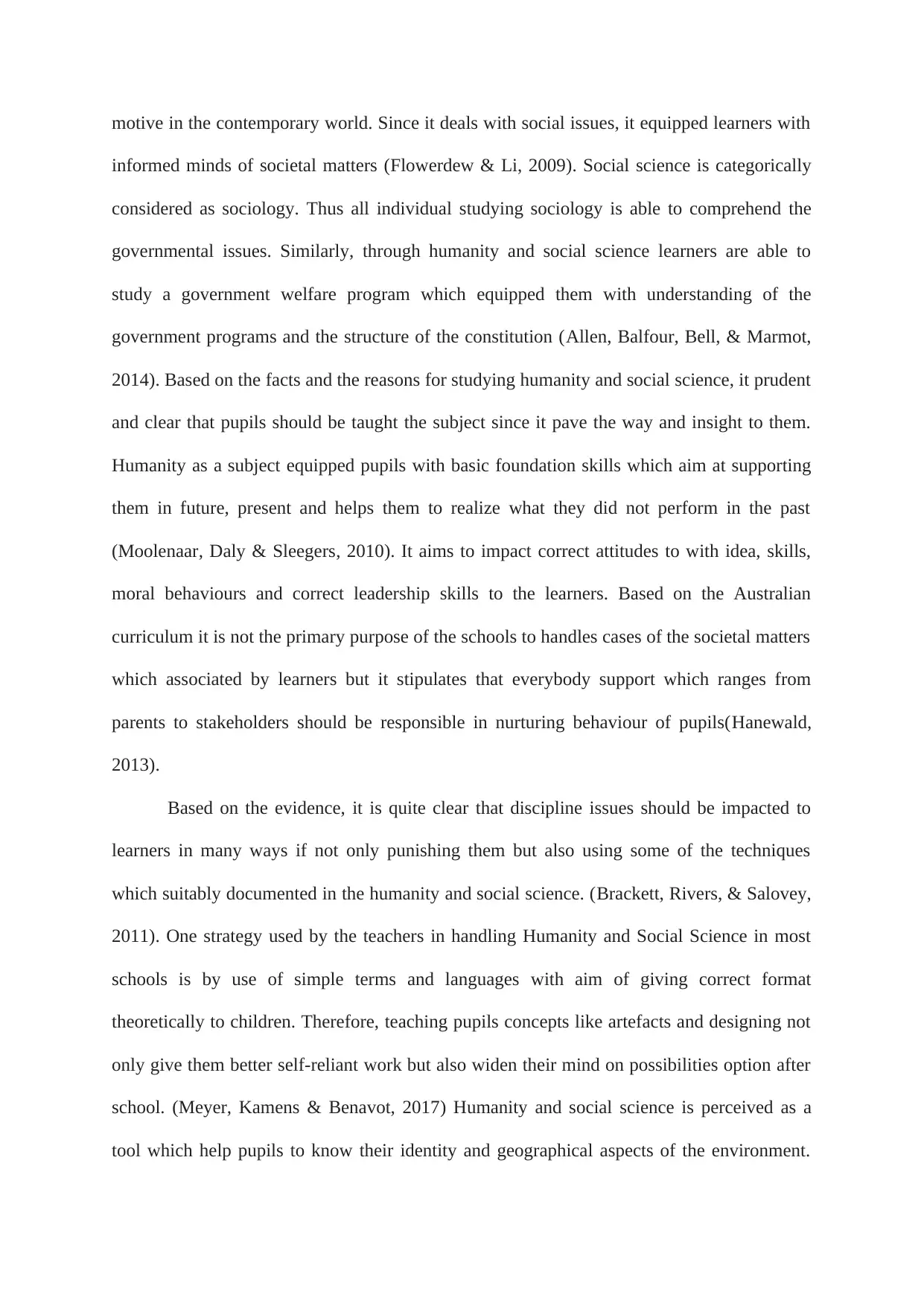
motive in the contemporary world. Since it deals with social issues, it equipped learners with
informed minds of societal matters (Flowerdew & Li, 2009). Social science is categorically
considered as sociology. Thus all individual studying sociology is able to comprehend the
governmental issues. Similarly, through humanity and social science learners are able to
study a government welfare program which equipped them with understanding of the
government programs and the structure of the constitution (Allen, Balfour, Bell, & Marmot,
2014). Based on the facts and the reasons for studying humanity and social science, it prudent
and clear that pupils should be taught the subject since it pave the way and insight to them.
Humanity as a subject equipped pupils with basic foundation skills which aim at supporting
them in future, present and helps them to realize what they did not perform in the past
(Moolenaar, Daly & Sleegers, 2010). It aims to impact correct attitudes to with idea, skills,
moral behaviours and correct leadership skills to the learners. Based on the Australian
curriculum it is not the primary purpose of the schools to handles cases of the societal matters
which associated by learners but it stipulates that everybody support which ranges from
parents to stakeholders should be responsible in nurturing behaviour of pupils(Hanewald,
2013).
Based on the evidence, it is quite clear that discipline issues should be impacted to
learners in many ways if not only punishing them but also using some of the techniques
which suitably documented in the humanity and social science. (Brackett, Rivers, & Salovey,
2011). One strategy used by the teachers in handling Humanity and Social Science in most
schools is by use of simple terms and languages with aim of giving correct format
theoretically to children. Therefore, teaching pupils concepts like artefacts and designing not
only give them better self-reliant work but also widen their mind on possibilities option after
school. (Meyer, Kamens & Benavot, 2017) Humanity and social science is perceived as a
tool which help pupils to know their identity and geographical aspects of the environment.
informed minds of societal matters (Flowerdew & Li, 2009). Social science is categorically
considered as sociology. Thus all individual studying sociology is able to comprehend the
governmental issues. Similarly, through humanity and social science learners are able to
study a government welfare program which equipped them with understanding of the
government programs and the structure of the constitution (Allen, Balfour, Bell, & Marmot,
2014). Based on the facts and the reasons for studying humanity and social science, it prudent
and clear that pupils should be taught the subject since it pave the way and insight to them.
Humanity as a subject equipped pupils with basic foundation skills which aim at supporting
them in future, present and helps them to realize what they did not perform in the past
(Moolenaar, Daly & Sleegers, 2010). It aims to impact correct attitudes to with idea, skills,
moral behaviours and correct leadership skills to the learners. Based on the Australian
curriculum it is not the primary purpose of the schools to handles cases of the societal matters
which associated by learners but it stipulates that everybody support which ranges from
parents to stakeholders should be responsible in nurturing behaviour of pupils(Hanewald,
2013).
Based on the evidence, it is quite clear that discipline issues should be impacted to
learners in many ways if not only punishing them but also using some of the techniques
which suitably documented in the humanity and social science. (Brackett, Rivers, & Salovey,
2011). One strategy used by the teachers in handling Humanity and Social Science in most
schools is by use of simple terms and languages with aim of giving correct format
theoretically to children. Therefore, teaching pupils concepts like artefacts and designing not
only give them better self-reliant work but also widen their mind on possibilities option after
school. (Meyer, Kamens & Benavot, 2017) Humanity and social science is perceived as a
tool which help pupils to know their identity and geographical aspects of the environment.
⊘ This is a preview!⊘
Do you want full access?
Subscribe today to unlock all pages.

Trusted by 1+ million students worldwide
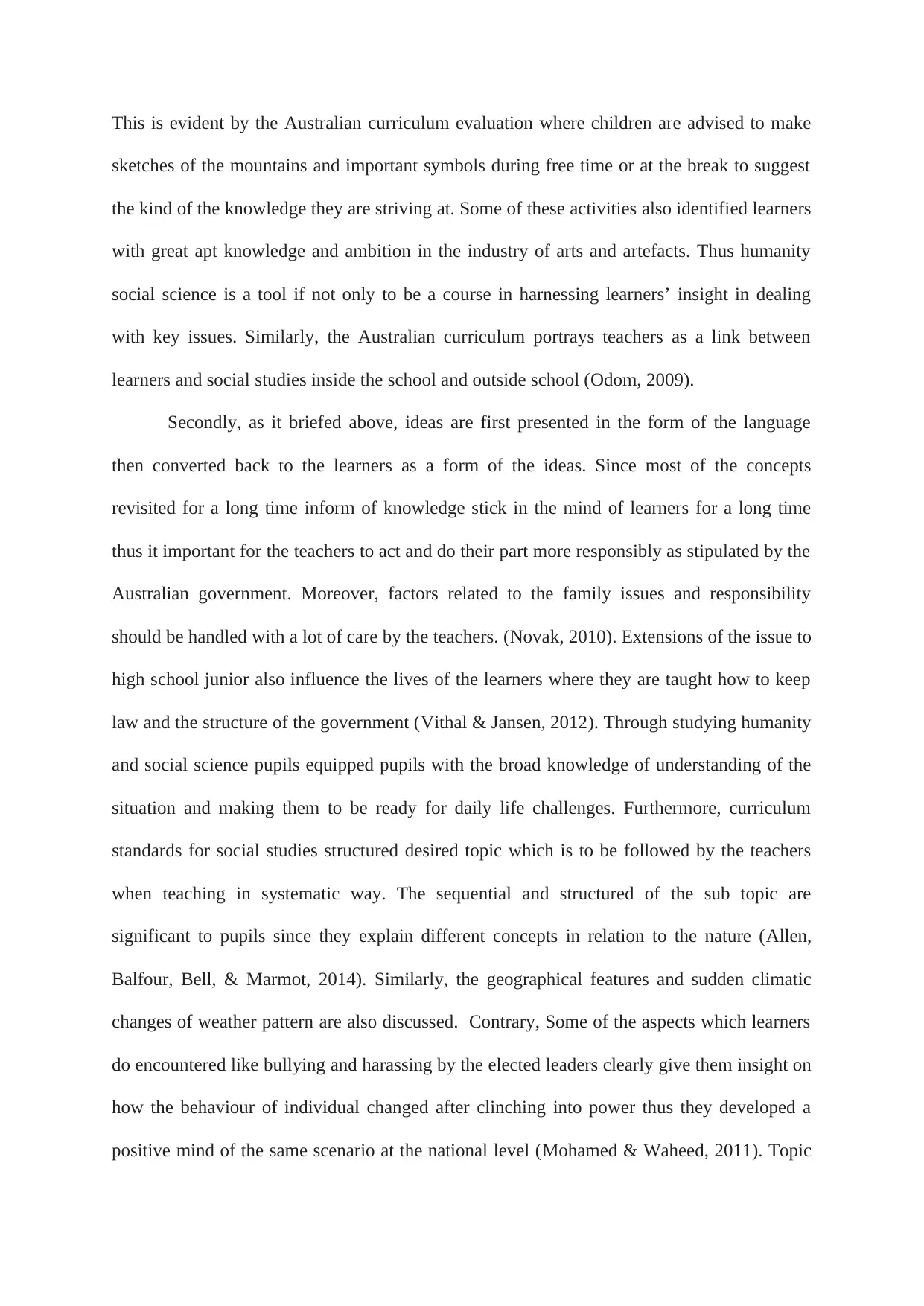
This is evident by the Australian curriculum evaluation where children are advised to make
sketches of the mountains and important symbols during free time or at the break to suggest
the kind of the knowledge they are striving at. Some of these activities also identified learners
with great apt knowledge and ambition in the industry of arts and artefacts. Thus humanity
social science is a tool if not only to be a course in harnessing learners’ insight in dealing
with key issues. Similarly, the Australian curriculum portrays teachers as a link between
learners and social studies inside the school and outside school (Odom, 2009).
Secondly, as it briefed above, ideas are first presented in the form of the language
then converted back to the learners as a form of the ideas. Since most of the concepts
revisited for a long time inform of knowledge stick in the mind of learners for a long time
thus it important for the teachers to act and do their part more responsibly as stipulated by the
Australian government. Moreover, factors related to the family issues and responsibility
should be handled with a lot of care by the teachers. (Novak, 2010). Extensions of the issue to
high school junior also influence the lives of the learners where they are taught how to keep
law and the structure of the government (Vithal & Jansen, 2012). Through studying humanity
and social science pupils equipped pupils with the broad knowledge of understanding of the
situation and making them to be ready for daily life challenges. Furthermore, curriculum
standards for social studies structured desired topic which is to be followed by the teachers
when teaching in systematic way. The sequential and structured of the sub topic are
significant to pupils since they explain different concepts in relation to the nature (Allen,
Balfour, Bell, & Marmot, 2014). Similarly, the geographical features and sudden climatic
changes of weather pattern are also discussed. Contrary, Some of the aspects which learners
do encountered like bullying and harassing by the elected leaders clearly give them insight on
how the behaviour of individual changed after clinching into power thus they developed a
positive mind of the same scenario at the national level (Mohamed & Waheed, 2011). Topic
sketches of the mountains and important symbols during free time or at the break to suggest
the kind of the knowledge they are striving at. Some of these activities also identified learners
with great apt knowledge and ambition in the industry of arts and artefacts. Thus humanity
social science is a tool if not only to be a course in harnessing learners’ insight in dealing
with key issues. Similarly, the Australian curriculum portrays teachers as a link between
learners and social studies inside the school and outside school (Odom, 2009).
Secondly, as it briefed above, ideas are first presented in the form of the language
then converted back to the learners as a form of the ideas. Since most of the concepts
revisited for a long time inform of knowledge stick in the mind of learners for a long time
thus it important for the teachers to act and do their part more responsibly as stipulated by the
Australian government. Moreover, factors related to the family issues and responsibility
should be handled with a lot of care by the teachers. (Novak, 2010). Extensions of the issue to
high school junior also influence the lives of the learners where they are taught how to keep
law and the structure of the government (Vithal & Jansen, 2012). Through studying humanity
and social science pupils equipped pupils with the broad knowledge of understanding of the
situation and making them to be ready for daily life challenges. Furthermore, curriculum
standards for social studies structured desired topic which is to be followed by the teachers
when teaching in systematic way. The sequential and structured of the sub topic are
significant to pupils since they explain different concepts in relation to the nature (Allen,
Balfour, Bell, & Marmot, 2014). Similarly, the geographical features and sudden climatic
changes of weather pattern are also discussed. Contrary, Some of the aspects which learners
do encountered like bullying and harassing by the elected leaders clearly give them insight on
how the behaviour of individual changed after clinching into power thus they developed a
positive mind of the same scenario at the national level (Mohamed & Waheed, 2011). Topic
Paraphrase This Document
Need a fresh take? Get an instant paraphrase of this document with our AI Paraphraser
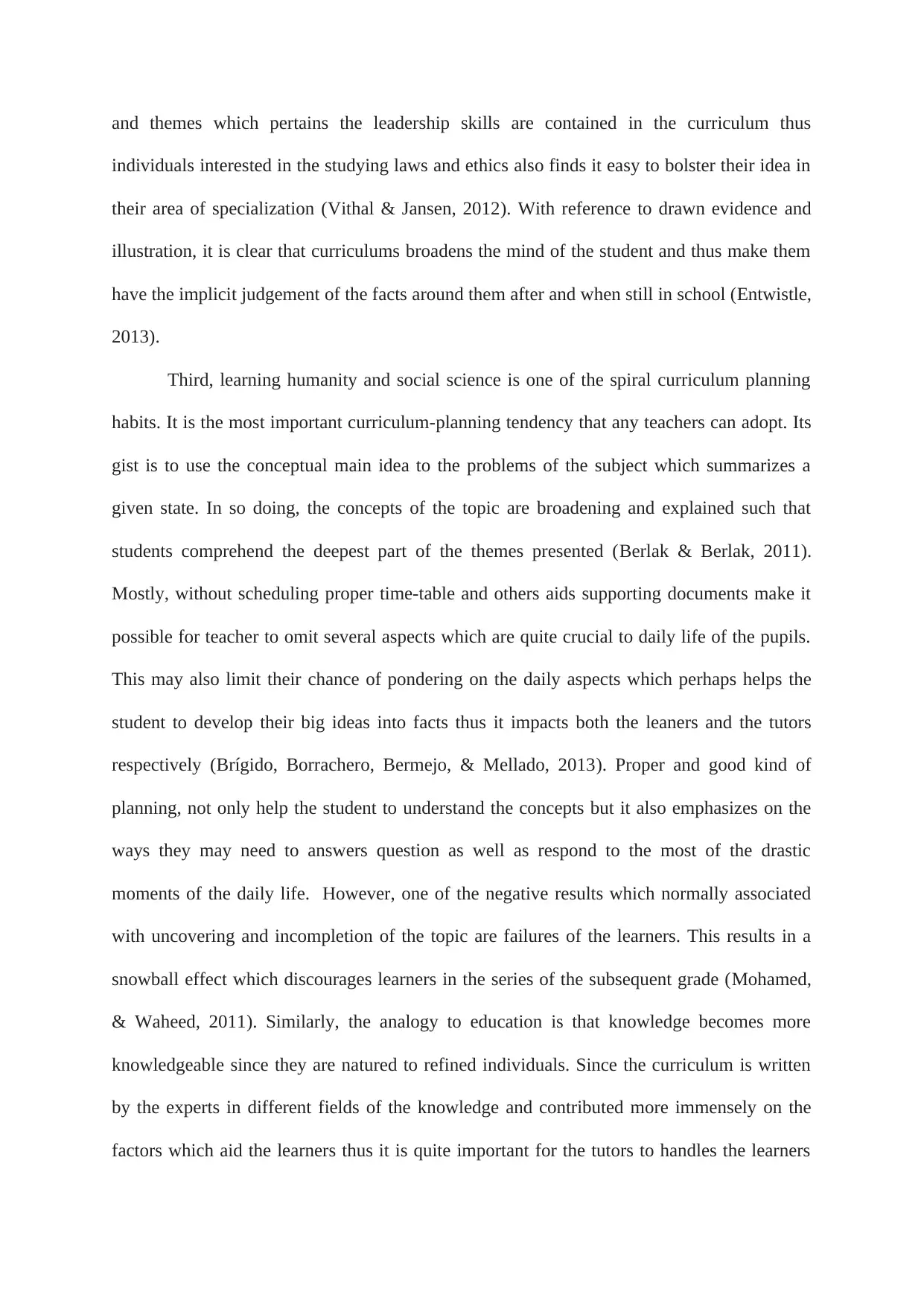
and themes which pertains the leadership skills are contained in the curriculum thus
individuals interested in the studying laws and ethics also finds it easy to bolster their idea in
their area of specialization (Vithal & Jansen, 2012). With reference to drawn evidence and
illustration, it is clear that curriculums broadens the mind of the student and thus make them
have the implicit judgement of the facts around them after and when still in school (Entwistle,
2013).
Third, learning humanity and social science is one of the spiral curriculum planning
habits. It is the most important curriculum-planning tendency that any teachers can adopt. Its
gist is to use the conceptual main idea to the problems of the subject which summarizes a
given state. In so doing, the concepts of the topic are broadening and explained such that
students comprehend the deepest part of the themes presented (Berlak & Berlak, 2011).
Mostly, without scheduling proper time-table and others aids supporting documents make it
possible for teacher to omit several aspects which are quite crucial to daily life of the pupils.
This may also limit their chance of pondering on the daily aspects which perhaps helps the
student to develop their big ideas into facts thus it impacts both the leaners and the tutors
respectively (Brígido, Borrachero, Bermejo, & Mellado, 2013). Proper and good kind of
planning, not only help the student to understand the concepts but it also emphasizes on the
ways they may need to answers question as well as respond to the most of the drastic
moments of the daily life. However, one of the negative results which normally associated
with uncovering and incompletion of the topic are failures of the learners. This results in a
snowball effect which discourages learners in the series of the subsequent grade (Mohamed,
& Waheed, 2011). Similarly, the analogy to education is that knowledge becomes more
knowledgeable since they are natured to refined individuals. Since the curriculum is written
by the experts in different fields of the knowledge and contributed more immensely on the
factors which aid the learners thus it is quite important for the tutors to handles the learners
individuals interested in the studying laws and ethics also finds it easy to bolster their idea in
their area of specialization (Vithal & Jansen, 2012). With reference to drawn evidence and
illustration, it is clear that curriculums broadens the mind of the student and thus make them
have the implicit judgement of the facts around them after and when still in school (Entwistle,
2013).
Third, learning humanity and social science is one of the spiral curriculum planning
habits. It is the most important curriculum-planning tendency that any teachers can adopt. Its
gist is to use the conceptual main idea to the problems of the subject which summarizes a
given state. In so doing, the concepts of the topic are broadening and explained such that
students comprehend the deepest part of the themes presented (Berlak & Berlak, 2011).
Mostly, without scheduling proper time-table and others aids supporting documents make it
possible for teacher to omit several aspects which are quite crucial to daily life of the pupils.
This may also limit their chance of pondering on the daily aspects which perhaps helps the
student to develop their big ideas into facts thus it impacts both the leaners and the tutors
respectively (Brígido, Borrachero, Bermejo, & Mellado, 2013). Proper and good kind of
planning, not only help the student to understand the concepts but it also emphasizes on the
ways they may need to answers question as well as respond to the most of the drastic
moments of the daily life. However, one of the negative results which normally associated
with uncovering and incompletion of the topic are failures of the learners. This results in a
snowball effect which discourages learners in the series of the subsequent grade (Mohamed,
& Waheed, 2011). Similarly, the analogy to education is that knowledge becomes more
knowledgeable since they are natured to refined individuals. Since the curriculum is written
by the experts in different fields of the knowledge and contributed more immensely on the
factors which aid the learners thus it is quite important for the tutors to handles the learners
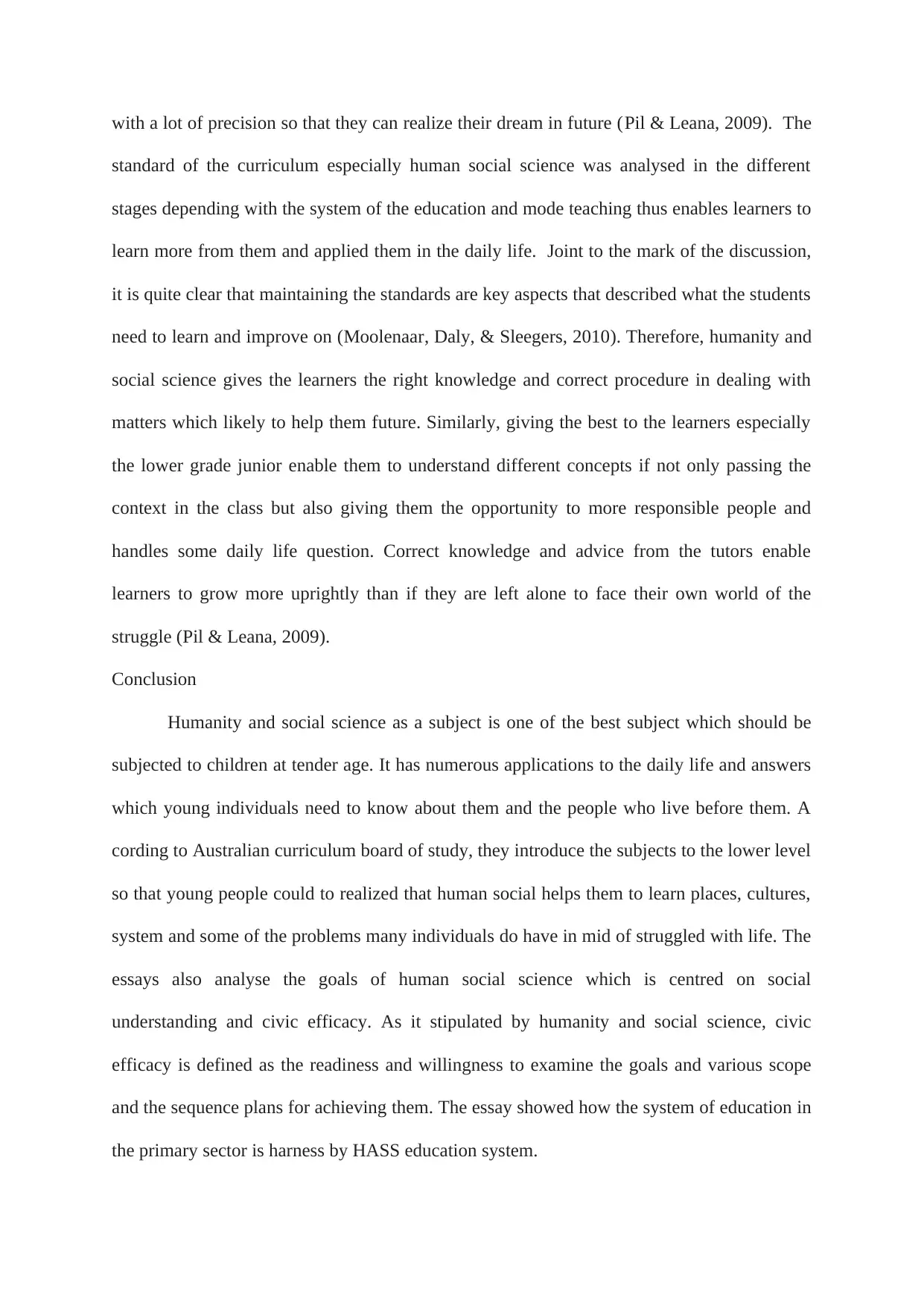
with a lot of precision so that they can realize their dream in future (Pil & Leana, 2009). The
standard of the curriculum especially human social science was analysed in the different
stages depending with the system of the education and mode teaching thus enables learners to
learn more from them and applied them in the daily life. Joint to the mark of the discussion,
it is quite clear that maintaining the standards are key aspects that described what the students
need to learn and improve on (Moolenaar, Daly, & Sleegers, 2010). Therefore, humanity and
social science gives the learners the right knowledge and correct procedure in dealing with
matters which likely to help them future. Similarly, giving the best to the learners especially
the lower grade junior enable them to understand different concepts if not only passing the
context in the class but also giving them the opportunity to more responsible people and
handles some daily life question. Correct knowledge and advice from the tutors enable
learners to grow more uprightly than if they are left alone to face their own world of the
struggle (Pil & Leana, 2009).
Conclusion
Humanity and social science as a subject is one of the best subject which should be
subjected to children at tender age. It has numerous applications to the daily life and answers
which young individuals need to know about them and the people who live before them. A
cording to Australian curriculum board of study, they introduce the subjects to the lower level
so that young people could to realized that human social helps them to learn places, cultures,
system and some of the problems many individuals do have in mid of struggled with life. The
essays also analyse the goals of human social science which is centred on social
understanding and civic efficacy. As it stipulated by humanity and social science, civic
efficacy is defined as the readiness and willingness to examine the goals and various scope
and the sequence plans for achieving them. The essay showed how the system of education in
the primary sector is harness by HASS education system.
standard of the curriculum especially human social science was analysed in the different
stages depending with the system of the education and mode teaching thus enables learners to
learn more from them and applied them in the daily life. Joint to the mark of the discussion,
it is quite clear that maintaining the standards are key aspects that described what the students
need to learn and improve on (Moolenaar, Daly, & Sleegers, 2010). Therefore, humanity and
social science gives the learners the right knowledge and correct procedure in dealing with
matters which likely to help them future. Similarly, giving the best to the learners especially
the lower grade junior enable them to understand different concepts if not only passing the
context in the class but also giving them the opportunity to more responsible people and
handles some daily life question. Correct knowledge and advice from the tutors enable
learners to grow more uprightly than if they are left alone to face their own world of the
struggle (Pil & Leana, 2009).
Conclusion
Humanity and social science as a subject is one of the best subject which should be
subjected to children at tender age. It has numerous applications to the daily life and answers
which young individuals need to know about them and the people who live before them. A
cording to Australian curriculum board of study, they introduce the subjects to the lower level
so that young people could to realized that human social helps them to learn places, cultures,
system and some of the problems many individuals do have in mid of struggled with life. The
essays also analyse the goals of human social science which is centred on social
understanding and civic efficacy. As it stipulated by humanity and social science, civic
efficacy is defined as the readiness and willingness to examine the goals and various scope
and the sequence plans for achieving them. The essay showed how the system of education in
the primary sector is harness by HASS education system.
⊘ This is a preview!⊘
Do you want full access?
Subscribe today to unlock all pages.

Trusted by 1+ million students worldwide
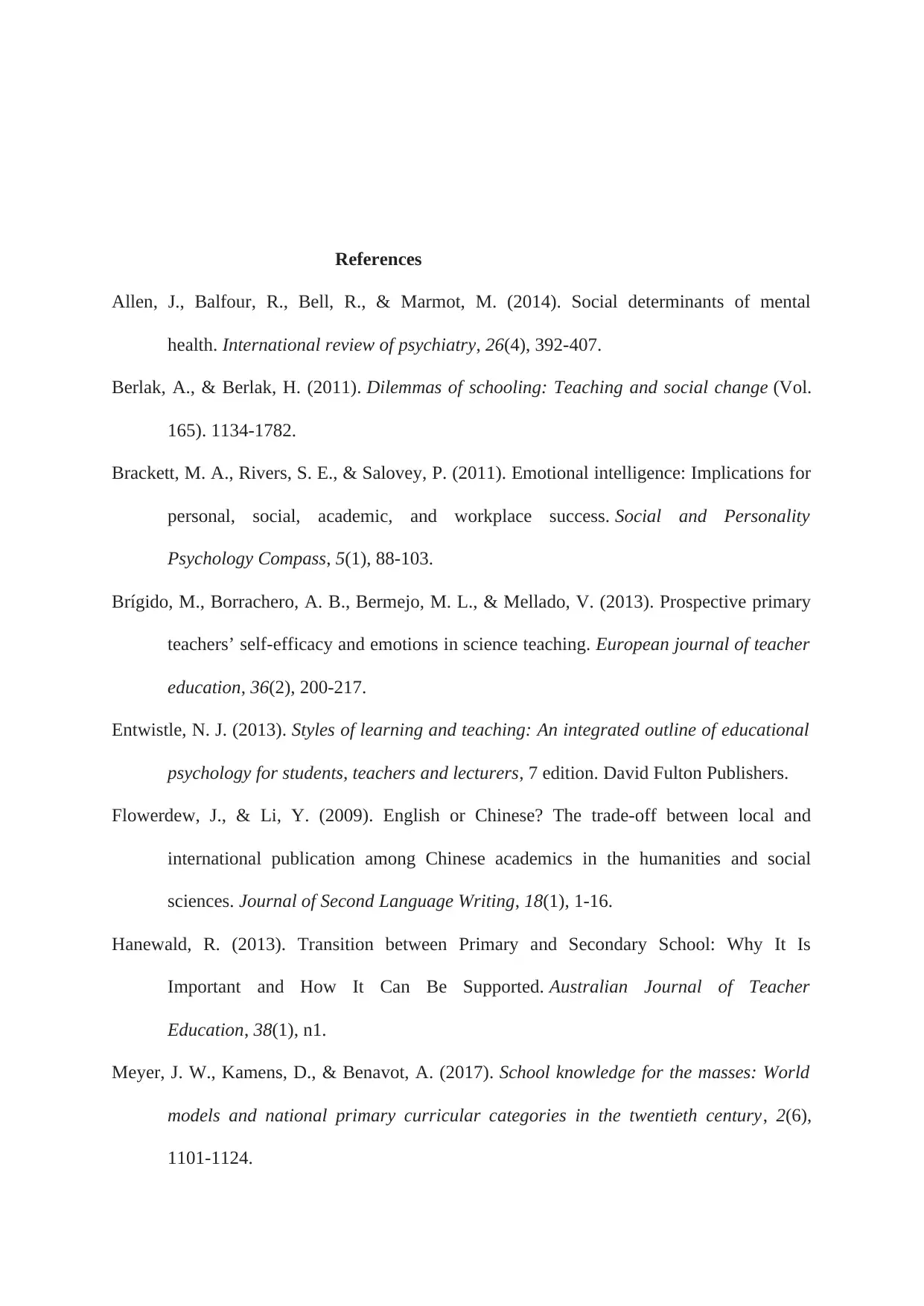
References
Allen, J., Balfour, R., Bell, R., & Marmot, M. (2014). Social determinants of mental
health. International review of psychiatry, 26(4), 392-407.
Berlak, A., & Berlak, H. (2011). Dilemmas of schooling: Teaching and social change (Vol.
165). 1134-1782.
Brackett, M. A., Rivers, S. E., & Salovey, P. (2011). Emotional intelligence: Implications for
personal, social, academic, and workplace success. Social and Personality
Psychology Compass, 5(1), 88-103.
Brígido, M., Borrachero, A. B., Bermejo, M. L., & Mellado, V. (2013). Prospective primary
teachers’ self-efficacy and emotions in science teaching. European journal of teacher
education, 36(2), 200-217.
Entwistle, N. J. (2013). Styles of learning and teaching: An integrated outline of educational
psychology for students, teachers and lecturers, 7 edition. David Fulton Publishers.
Flowerdew, J., & Li, Y. (2009). English or Chinese? The trade-off between local and
international publication among Chinese academics in the humanities and social
sciences. Journal of Second Language Writing, 18(1), 1-16.
Hanewald, R. (2013). Transition between Primary and Secondary School: Why It Is
Important and How It Can Be Supported. Australian Journal of Teacher
Education, 38(1), n1.
Meyer, J. W., Kamens, D., & Benavot, A. (2017). School knowledge for the masses: World
models and national primary curricular categories in the twentieth century, 2(6),
1101-1124.
Allen, J., Balfour, R., Bell, R., & Marmot, M. (2014). Social determinants of mental
health. International review of psychiatry, 26(4), 392-407.
Berlak, A., & Berlak, H. (2011). Dilemmas of schooling: Teaching and social change (Vol.
165). 1134-1782.
Brackett, M. A., Rivers, S. E., & Salovey, P. (2011). Emotional intelligence: Implications for
personal, social, academic, and workplace success. Social and Personality
Psychology Compass, 5(1), 88-103.
Brígido, M., Borrachero, A. B., Bermejo, M. L., & Mellado, V. (2013). Prospective primary
teachers’ self-efficacy and emotions in science teaching. European journal of teacher
education, 36(2), 200-217.
Entwistle, N. J. (2013). Styles of learning and teaching: An integrated outline of educational
psychology for students, teachers and lecturers, 7 edition. David Fulton Publishers.
Flowerdew, J., & Li, Y. (2009). English or Chinese? The trade-off between local and
international publication among Chinese academics in the humanities and social
sciences. Journal of Second Language Writing, 18(1), 1-16.
Hanewald, R. (2013). Transition between Primary and Secondary School: Why It Is
Important and How It Can Be Supported. Australian Journal of Teacher
Education, 38(1), n1.
Meyer, J. W., Kamens, D., & Benavot, A. (2017). School knowledge for the masses: World
models and national primary curricular categories in the twentieth century, 2(6),
1101-1124.
Paraphrase This Document
Need a fresh take? Get an instant paraphrase of this document with our AI Paraphraser
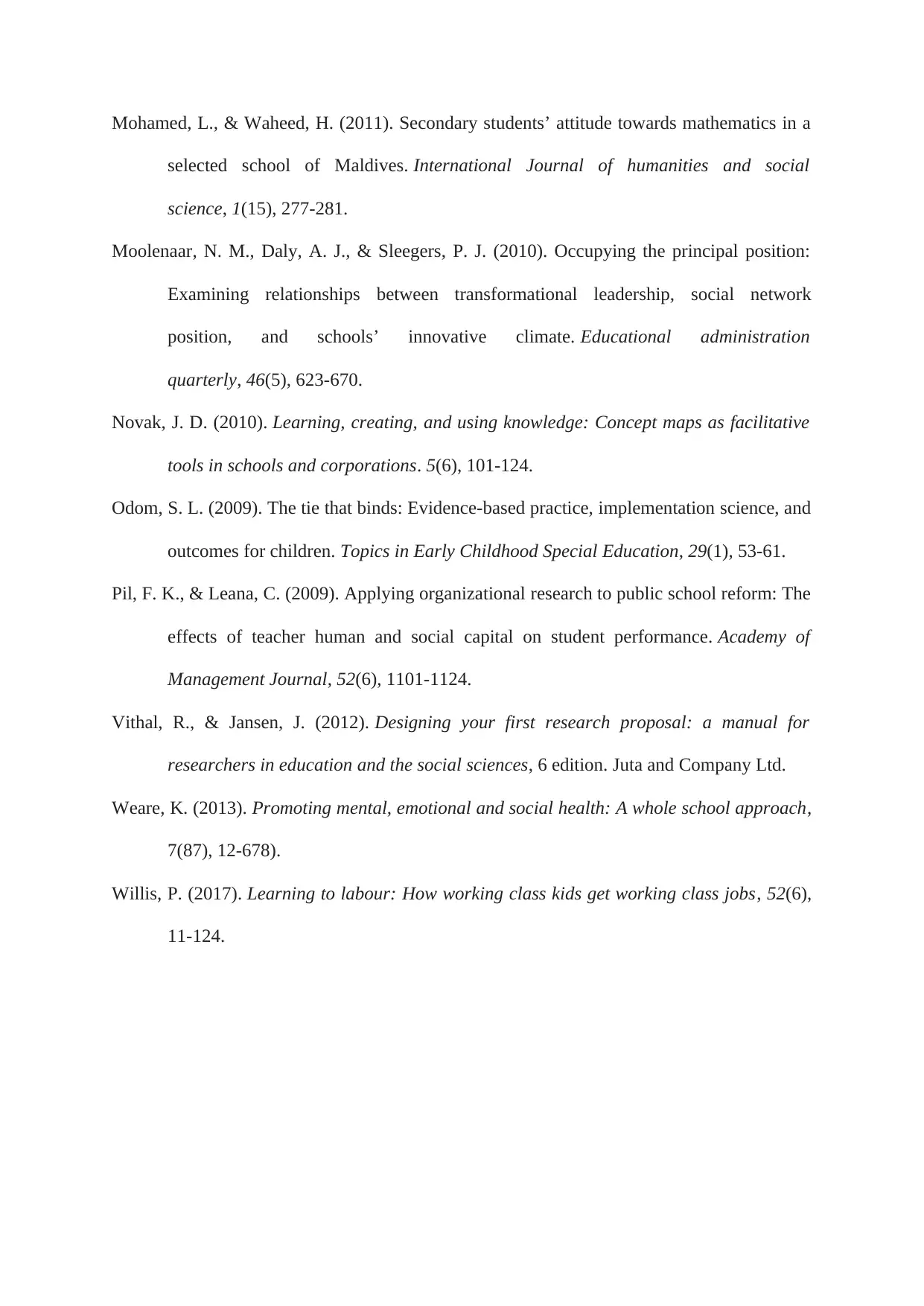
Mohamed, L., & Waheed, H. (2011). Secondary students’ attitude towards mathematics in a
selected school of Maldives. International Journal of humanities and social
science, 1(15), 277-281.
Moolenaar, N. M., Daly, A. J., & Sleegers, P. J. (2010). Occupying the principal position:
Examining relationships between transformational leadership, social network
position, and schools’ innovative climate. Educational administration
quarterly, 46(5), 623-670.
Novak, J. D. (2010). Learning, creating, and using knowledge: Concept maps as facilitative
tools in schools and corporations. 5(6), 101-124.
Odom, S. L. (2009). The tie that binds: Evidence-based practice, implementation science, and
outcomes for children. Topics in Early Childhood Special Education, 29(1), 53-61.
Pil, F. K., & Leana, C. (2009). Applying organizational research to public school reform: The
effects of teacher human and social capital on student performance. Academy of
Management Journal, 52(6), 1101-1124.
Vithal, R., & Jansen, J. (2012). Designing your first research proposal: a manual for
researchers in education and the social sciences, 6 edition. Juta and Company Ltd.
Weare, K. (2013). Promoting mental, emotional and social health: A whole school approach,
7(87), 12-678).
Willis, P. (2017). Learning to labour: How working class kids get working class jobs, 52(6),
11-124.
selected school of Maldives. International Journal of humanities and social
science, 1(15), 277-281.
Moolenaar, N. M., Daly, A. J., & Sleegers, P. J. (2010). Occupying the principal position:
Examining relationships between transformational leadership, social network
position, and schools’ innovative climate. Educational administration
quarterly, 46(5), 623-670.
Novak, J. D. (2010). Learning, creating, and using knowledge: Concept maps as facilitative
tools in schools and corporations. 5(6), 101-124.
Odom, S. L. (2009). The tie that binds: Evidence-based practice, implementation science, and
outcomes for children. Topics in Early Childhood Special Education, 29(1), 53-61.
Pil, F. K., & Leana, C. (2009). Applying organizational research to public school reform: The
effects of teacher human and social capital on student performance. Academy of
Management Journal, 52(6), 1101-1124.
Vithal, R., & Jansen, J. (2012). Designing your first research proposal: a manual for
researchers in education and the social sciences, 6 edition. Juta and Company Ltd.
Weare, K. (2013). Promoting mental, emotional and social health: A whole school approach,
7(87), 12-678).
Willis, P. (2017). Learning to labour: How working class kids get working class jobs, 52(6),
11-124.
1 out of 8
Related Documents
Your All-in-One AI-Powered Toolkit for Academic Success.
+13062052269
info@desklib.com
Available 24*7 on WhatsApp / Email
![[object Object]](/_next/static/media/star-bottom.7253800d.svg)
Unlock your academic potential
Copyright © 2020–2025 A2Z Services. All Rights Reserved. Developed and managed by ZUCOL.





